Total Eclipse Features
Corona
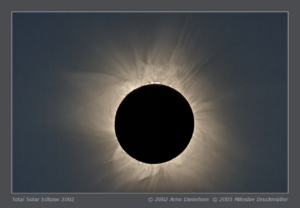

During the totality, the moon completely covers the sun’s glowing orb, and the sun’s outer atmosphere is revealed. As if the moon were the center of a celestial sunflower, the corona appears as soft white petals, massive flumes of faint light that taper out across the sky. Closer to the surface of the moon’s flat ebony circle, the corona is a swirling chaos of loops and flares. Intense fiery lines of light appear to ignite the moon’s black edge.
How to interact with the rumble map
On the rumble map, explore the difference between the moon and the sun’s corona. You will hear/feel variations as your fingers pass over different features of the corona.
Additional scientific info:
The corona is the thin outer atmosphere of the Sun. With temperatures at over 1 million degrees Fahrenheit, it radiates light in wavelengths that are too short for the human eye to see (like X-rays) and that are absorbed by the Earth’s atmosphere. However, the corona reflects some of the white light from the Sun’s photosphere below it. This faint reflection is only seen when the much brighter photosphere is blocked, like during a total eclipse.
Helmet Streamers
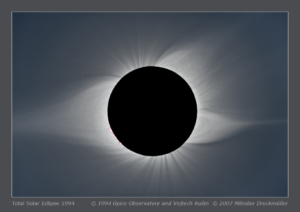

Projections of light from the sun’s outer atmosphere called helmet streamers extend in all directions from behind the moon. In contrast to the black, featureless moon, the pale, wispy streamers appear as delicate as lace. The largest streamers have a tapered shape that resemble flower petals. They extend from opposite sides of the sun, with smaller rays of light between them.
Explanation of what you might feel as you interact:
As you trace your finger along a helmet streamer, you can feel the smooth arches come to long sharp points as they extend from the base of the Sun outward.
Additional scientific info:
Helmet streamers get their shape from two different processes. The arch shape of streamers come from magnetic fields from concentrations of magnetic field on the surface of the Sun extending out into the corona and then arching back down to the surface to connect to other regions of magnetic field of opposite polarity. The long, pointed tops of helmet streamers come from streams of gas flowing out from the corona into interplanetary space forming the solar wind.
Prominence
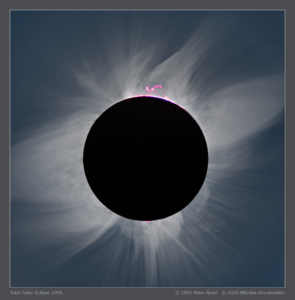

Fiery loops of hot pink light appear to leap off the moon’s black surface. With the sheer white corona as their backdrop, these pink prominences seem to dance above the moon like lines of liquid neon.
Explanation of what you might feel as you interact
You will notice a sharp contrast when you interact with a prominence due to its intense brightness relative to both the moon and the sun’s corona.
Additional scientific info
Prominences are magnetic fields that are filled with very dense material making them much brighter than the surrounding background. The magnetic fields of prominences can be very complicated giving them complex and dynamic shapes.
Baily’s Beads
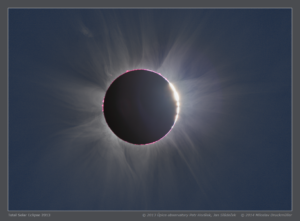

On the right side of the moon, orbs of glowing sunlight shimmer off the edge of the moon’s black disk. Called Baily’s Beads, these final areas of the sun’s light appear as glimmering pearls on a wire, made intensely bright by the absence of light surrounding them.
Explanation of what you might feel as you interact
On the rumble map, explore the difference between the moon, the sun’s corona and Baily’s beads which are intense and irregular.
Additional scientific info
Even this small section of the Sun’s light cannot be viewed without special eye protection. Please use special eclipse glasses or filters if viewing this feature directly on the Sun with your eyes. Baily’s beads are caused because the moon’s surface is not a smooth, perfect sphere. This spectacular feature is caused by rays of sunlight beaming through the ravines and valleys between mountains on the moon.
Diamond Ring
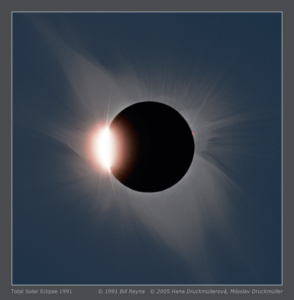

On the left side of the black moon, a sliver of sunlight blasts into view with white-hot intensity. As the area of re-emerging sunlight grows, it resembles a diamond, beaming out its brilliant light from its setting on the circular ring of the moon’s edge.
Additional scientific info
Even this small section of the Sun’s light cannot be viewed without special eye protection. Please use special eclipse glasses or filters if viewing this feature directly on the Sun with your eyes. As the moon barely moves away from the solar surface, the powerful light of the Sun peers around the side of the moon. This light is so intense that even this small fraction of it dominates the sky.
Totality


This is the full eclipse, when the moon’s black disk completely covers the sun. Now, in the absence of the sun’s full light, its massive outer corona is revealed. Uniquely visible during a full eclipse, grand flourishes of light called helmet streamers extend in all directions behind the moon’s black disk. At the edge of the moon, the helmet streamers are intensely bright, fading to wisps of ghostly white as they stretch across space, far from the moon, like flower petals.
Explanation of what you might feel as you interact
On the rumble map, explore the difference between the moon and the sun’s corona.
Additional scientific info
You may notice changes in temperature and natural sounds, such a birds and wind during the total eclipse.
During the total solar eclipse, and only during totality, you can view the corona of the Sun without eye protection. The Sun’s outer atmosphere, the corona, is in full display and viewable from the ground. The highly structured nature of the corona is clearly evident. This structure is caused by the Sun’s intense and complicated magnetic fields interacting with the material that makes up the corona. This material is called a plasma, which is like a gas, but is susceptible to magnetic fields. The magnetic fields can then shape the plasma in the corona into the complicated patterns that are viewable during the eclipse.